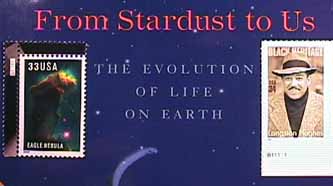

If you took known geological history, and laid it out on a timeline at a scale of a million years to a foot, you would have a one mile long chart. This is fully a third of the estimated life of the universe. I walked such a timeline in mid April of 1999, at Stanford University. I found that it had enough detail to explain the Gaia hypothesis (that life and geology coevolve) in a way that makes a lot of sense. Allow me to share with you the highest of the highlights of that walk.
Life first took hold about 3900 MYA (Million Years Ago) in a primordial soup that had been around since about 4100 MYA. The first life forms were very simple, bacteria and such. About 3700 MYA ago photosynthesis was discovered. The first big earth changes made by life were things like huge gold deposits in South Africa, which were precipitated out by bacterial feeding about 2900 MYA. By this time microbes have evolved every metabolic mode known to modern science. Not long after that (2800 MYA) predators first appeared.
The next period was marked by steadily more sophisticated cell structure. Organisms that had stood on their own in the primordial soup were forced into symbiotic relationships to survive. The first major extinction occurred when mass photosynthesis put so much oxygen in the atmosphere that it killed 90% of the anaerobic bacteria that had been the dominant life form before then (1900 MYA). Sexual behavior first evolved as a survival strategy about 1500 MYA.
Land was first settled by bacteria about 1400 MYA. The concept of an individual with a personality begins to become relevant about 1200 MYA. Animals are thought to begin to roam about 600 MYA, although the chordata (ones with backbones) did not appear until 505 MYA, about the time of the original green movement toward land. Real plants evolved on dry land about 455 MYA. From that point to this, the story is remarkably similar to the one I learned as a child. Human history was covered in one large panel I could read in a few minutes, the last one.
After absorbing the whole thing I was hungry. I decided to eat on California Avenue in Palo Alto, ending up in a place called Mediterranean Wraps run by three Jordanian Engineers. While I was waiting for my food, I browsed the currency collection on the back wall of the restaurant. There were many kinds of money I hadn't seen before there, including things like 1 Real notes from Brazil. The only American note that was green side up was a bicentennial $2 bill. The sight of the founding fathers signing the Declaration of Independence with "in god we trust" in the fine print added something to the day.
While I was eating I found myself wondering how the information density in the brain of the old woman on the cell phone I passed a billion years into the walk compared to the information density on the hard disk of my computer under normal operating conditions. Browsing the book version of A Walk Through Time, which contains all of the slides I saw during the walk, along with quite a bit of additional detail, it says a normal human lifespan is .001 inches on the scale of the chart. They have to be somewhat comparable. For more information visit http://www.globalcommunity.org/wtt.
Tian Harter
A year later the walk was on the UC Berkeley Campus. I saw Julia Butterfly Hill gave a speech at the modern end that time.
In 2001 it was in Mitchel Park, just across the fence from Stevenson House, the place where my Grandmother spent the last fifteen years or so of her life.